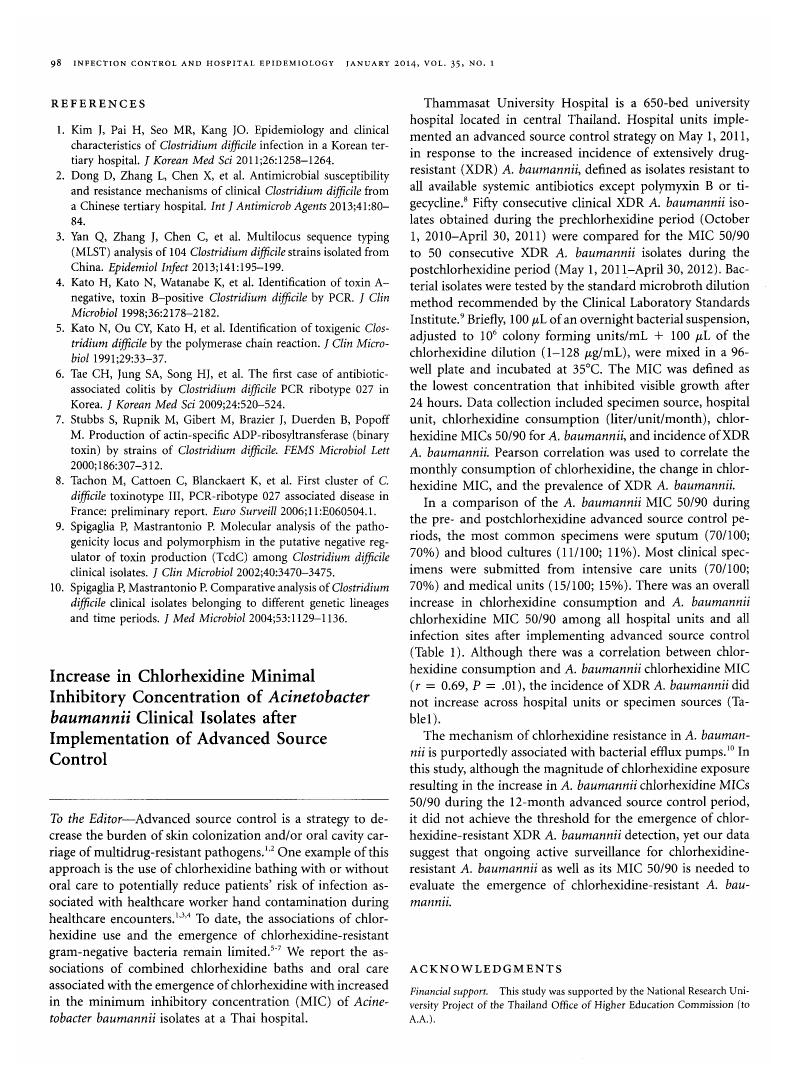Crossref Citations
This article has been cited by the following publications. This list is generated based on data provided by Crossref.
Maiwald, M.
and
Chan, E. S.- Y.
2014.
Pitfalls in evidence assessment: the case of chlorhexidine and alcohol in skin antisepsis.
Journal of Antimicrobial Chemotherapy,
Vol. 69,
Issue. 8,
p.
2017.
Suwantarat, Nuntra
Carroll, Karen C.
Tekle, Tsigereda
Ross, Tracy
Maragakis, Lisa L.
Cosgrove, Sara E.
and
Milstone, Aaron M.
2014.
High Prevalence of Reduced Chlorhexidine Susceptibility in Organisms Causing Central Line–Associated Bloodstream Infections.
Infection Control & Hospital Epidemiology,
Vol. 35,
Issue. 9,
p.
1183.
Cassir, N.
Papazian, L.
Fournier, P.-E.
Raoult, D.
and
La Scola, B.
2015.
Insights into bacterial colonization of intensive care patients’ skin: the effect of chlorhexidine daily bathing.
European Journal of Clinical Microbiology & Infectious Diseases,
Vol. 34,
Issue. 5,
p.
999.
Jamal, Mohamed A.
Hachem, Ray Y.
Rosenblatt, Joel
McArthur, Mark J.
Felix, Edd
Jiang, Ying
Tailor, Ramesh C.
and
Raad, Issam
2015.
In Vivo
Biocompatibility and
In Vitro
Efficacy of Antimicrobial Gendine-Coated Central Catheters
.
Antimicrobial Agents and Chemotherapy,
Vol. 59,
Issue. 9,
p.
5611.
Chung, Yun Kyung
Kim, Jae-Seok
Lee, Seung Soon
Lee, Jeong-a
Kim, Han-Sung
Shin, Kyong-sok
Park, Eun Young
Kang, Bog Soun
Lee, Hee Jung
and
Kang, Hyun Joo
2015.
Effect of daily chlorhexidine bathing on acquisition of carbapenem-resistant Acinetobacter baumannii (CRAB) in the medical intensive care unit with CRAB endemicity.
American Journal of Infection Control,
Vol. 43,
Issue. 11,
p.
1171.
Cassir, Nadim
Thomas, Guillemette
Hraiech, Sami
Brunet, Julie
Fournier, Pierre-Edouard
La Scola, Bernard
and
Papazian, Laurent
2015.
Chlorhexidine daily bathing: Impact on health care–associated infections caused by gram-negative bacteria.
American Journal of Infection Control,
Vol. 43,
Issue. 6,
p.
640.
Fernández-Cuenca, Felipe
Tomás, María
Caballero-Moyano, Francisco-Javier
Bou, Germán
Martínez-Martínez, Luis
Vila, Jordi
Pachón, Jerónimo
Cisneros, José-Miguel
Rodríguez-Baño, Jesús
Pascual, Álvaro
Garnacho, José
Gutierrez-Pizarraya, Antonio
Márquez-Vácaro, Juan Antonio
Cano, María Eliecer
Fariñas, M. Carmen
Sánchez-Porto, Antonio
Meruendano, Gloria Esteban
Barbeyto-Vales, Luis
Casas-Ciria, Javier
Vallejo, Luis
Fernández-Pérez, Begona
Villar-Chao, José Carlos
Padilla-Ortega, Belén
Cercenado-Mansilla, Emilia
García-Irure, José Javier
del Arco Jiménez, Alfonso
Gimeno-Cardona, Concepción
Valía, Juan Carlos
Tormo-Palop, Núria
Abril, Vicente
Rifa, Josefina
Martinez-Garcia, Maria Jesus
Vilaró-Pujals, Joseph
Aguirre, Marian Navarro
Vilamala, Ana
Jiménez-Alfaro, José Antonio
Reviejo-Jaca, Carlos
Casanova, Pilar Marín
Guerreo, Francisca
Shaw, Evelyn
Plasencia, Virginia
Nebreda-Mayoral, Teresa
Fernández-Calavia, María José
de Cruz, Susana García
Aldea-Mansilla, Carmen
de Lucas, Esperanza Merino
Zorraquino, Alfredo
Reus-Bañuls, Sergio
Garduno-Eseverri, Eugenio
Sánchez, Luis López
Fleites-Gutiérrez, Ana
Rodríguez-Guardado, Azucena
Moreno, Alfonso
García-Arenzana Anguera, José María
López-Palmero, Serafín
Rodríguez-Maresca, Manuel
García-Garrote, Fernando
Varela-Otero, José
del Pilar Alonso, María
Vidal-Verdú, Elisa
Rodríguez-López, Fernando
Pardo-Sánchez, Fernanda
Ferrer-Vizoso, E.
Regueiro-Garcia, B.
Gurgui, Mercé
Pericas, Roser
Pomar, Virginia
Olaechea-Astigarraga, Pedro María
Ayarza-Igartua, Rafael
Maciá-Romero, María Dolores
de Gopegui-Bordes, Enrique Ruiz
Sánchez-Romero, María Isabel
García-Mata, Jesús
Goyanes, María José
Morales-Mateos, Cristina
Hernández-Quero, José
Escobar-Lara, Trinidad
Ballester-Bastardie, Frederic
Iftimie, Simona
Pujol-Bajador, Isabel
Galán-Navarro, María Isabel
Cádiz-Gurrea, María Luz
Amores-Antequera, Carmen
Gómez, Montserrat
Cantudo, Purificación
Martí-Salas, Carmina
Cuquet-Peragosa, Jordi
Moreno-Flores, Antonio
Anibarro-García, Luis
Hernando-Real, Susana
Carrero-González, Pablo A.
Pallarés-González, María Angeles
Rodríguez-Fernández, Sergio
Pujol-Rojo, Miquel
Tubau, Fe
Nuno-Alvarez, Enrique
Ortega-Torres, María
Giner-Almaraz, Salvador
Roca-Castelló, María Rosa
Castillo, Manuela
Hortelano, Elena
Chaves-Sánchez, Fernando
García-Reyne, Ana
Horcajada-Gallego, Juan Pablo
Segura, Concha
Sierra-Dorado, Gema
Yano-Escudero, Raquel
Dorta-Hung, María Elena
and
del Rosario Q, Cristóbal
2015.
Reduced susceptibility to biocides in Acinetobacter baumannii: association with resistance to antimicrobials, epidemiological behaviour, biological cost and effect on the expression of genes encoding porins and efflux pumps.
Journal of Antimicrobial Chemotherapy,
Vol. 70,
Issue. 12,
p.
3222.
Kampf, G.
2016.
Acquired resistance to chlorhexidine – is it time to establish an ‘antiseptic stewardship’ initiative?.
Journal of Hospital Infection,
Vol. 94,
Issue. 3,
p.
213.
Alvarez-Marin, R.
Aires-de-Sousa, M.
Nordmann, P.
Kieffer, N.
and
Poirel, L.
2017.
Antimicrobial activity of octenidine against multidrug-resistant Gram-negative pathogens.
European Journal of Clinical Microbiology & Infectious Diseases,
Vol. 36,
Issue. 12,
p.
2379.
Madden, Gregory R.
and
Sifri, Costi D.
2018.
Antimicrobial Resistance to Agents Used for Staphylococcus aureus Decolonization: Is There a Reason for Concern?.
Current Infectious Disease Reports,
Vol. 20,
Issue. 8,
Patel, Aditi
Parikh, Parth
Dunn, Aaron N.
Otter, Jonathan A.
Thota, Priyaleela
Fraser, Thomas G.
Donskey, Curtis J.
and
Deshpande, Abhishek
2019.
Effectiveness of daily chlorhexidine bathing for reducing gram-negative infections: A meta-analysis.
Infection Control & Hospital Epidemiology,
Vol. 40,
Issue. 4,
p.
392.
Reitzel, Ruth A
Rosenblatt, Joel
Gerges, Bahgat Z
Jarjour, Andrew
Fernández-Cruz, Ana
and
Raad, Issam I
2020.
The potential for developing new antimicrobial resistance from the use of medical devices containing chlorhexidine, minocycline, rifampicin and their combinations: a systematic review.
JAC-Antimicrobial Resistance,
Vol. 2,
Issue. 1,
Babiker, Ahmed
Lutgring, Joseph D
Fridkin, Scott
and
Hayden, Mary K
2021.
Assessing the Potential for Unintended Microbial Consequences of Routine Chlorhexidine Bathing for Prevention of Healthcare-associated Infections.
Clinical Infectious Diseases,
Vol. 72,
Issue. 5,
p.
891.
Leshem, Tamar
Gilron, Shani
Azrad, Maya
and
Peretz, Avi
2022.
Characterization of reduced susceptibility to chlorhexidine among Gram-negative bacteria.
Microbes and Infection,
Vol. 24,
Issue. 2,
p.
104891.



